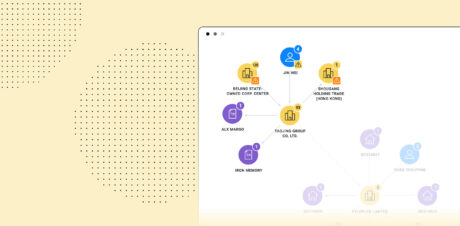Bifurcation is the splitting of a supply or distribution chain that results in parallel lines for different markets or regions. Bifurcation can occur for many reasons. Sometimes importers maintain trade relationships with potentially risky suppliers because these suppliers promise a compliant product via bifurcation. In other cases, importers may unwittingly participate in a bifurcated supply chain. Bifurcated distribution chains can also occur as a response to tariff mitigation efforts. Finally, geopolitical concerns can cause bifurcated supply chains when organizations work to address potential national security risks.
Beyond introducing complexity and increased operational costs, bifurcated chains also pose risk to downstream organizations. For example, when bifurcation is used in response to forced labor regulations, it is virtually impossible for the importing company to guarantee a compliant supply chain of inputs. Evading tariffs through transshipment and bifurcated distribution chains poses significant legal risk.
Let’s walk through how bifurcation appears in global trade today and how organizations can address risks associated with bifurcation.
How bifurcation manifests itself in global supply and distribution chains
Bifurcation as a response to forced labor regulations
Suppliers operating in China may offer a supposedly forced labor-free supply chain to comply with the Uyghur Forced Labor Prevention Act (UFLPA) ban in the U.S. while serving other less-regulated markets with goods made with Uyghur forced labor. Suppliers may promise forced labor-free goods to U.S. buyers, but it’s hard for sourcers to verify this claim and guarantee their supply chain is compliant.
The solar industry is particularly at risk for inputs from forced labor. Polysilicon is used in solar panels, and solar energy is stored in lithium-ion batteries that use cobalt cathodes. Approximately 40-45 percent of the polysilicon now used in solar panels comes from Xinjiang. Fifteen to thirty percent of global cobalt supply is mined in the Democratic Republic of the Congo, where forced and child labor is common.
Investigation and analysis by Sheffield Hallam University (SHU) put a spotlight on bifurcated supply chains within the solar industry to highlight how companies are producing some product lines that include Xinjiang inputs and others that they claim do not. While these companies claim their supply chains are bifurcated to comply with regulations, batches of MGS or polysilicon sourced from different locations are often blended, possibly introducing Xinjiang-sourced materials into any batch. There is little certainty on the part of governments and consumers regarding “slavery-free” supply chains vs “slave-made” supply chains.
>> Discover resources to manage forced labor risk in supply chains <<
Bifurcation as a response to tariff imposition
Bifurcated supply chains can also be found as a response to tariff imposition. Many American companies sourcing apparel, footwear, and other goods sell to customers globally. Section 301 tariffs have required these companies to shift sourcing destined for the U.S. out of China to producers in other countries. These American companies can continue to supply customers in tariff-free locations from their Chinese suppliers, while using non-China inputs for the U.S. market.
In addition, some companies resort to transshipment which, while often legal, becomes illegal when organizations attempt to disguise the country of origin. Section 301 tariffs have prompted some China-based suppliers to shift their exports to other countries with lower-duty rates for potential onward shipment to U.S. buyers, resulting in bifurcated distribution chains, and obscured origins for goods that otherwise would be subject to higher tariffs.
>> Learn how to identify alternative sourcing options to minimize tariff exposure <<
Bifurcation as a response to geopolitical concerns
Bifurcated supply chains are also becoming more prevalent in the technology sector as a result of national security concerns regarding China. For example, laws in China authorize the Chinese Communist Party (CCP) to harvest data from China-based commercial entities. These security concerns are driving a reduced reliance on China that results in U.S.-controlled and China-controlled supply chains in this sector.
The CHIPS and Science Act and additions to the BIS Entity List further increase the risk of bifurcated high-tech supply chains. OEMs and their suppliers could end up building one supply chain to serve the Chinese market that uses Chinese-designed, -developed, and -manufactured products and another to supply the rest of the world. Higher prices, disrupted supply in the West, and poorer product choice in China are the likely results.
Example: Bifurcation via transshipment to avoid tariffs
While we are in the early days of the Trump administration’s use of tariffs, prior responses to tariffs reveal how bifurcated supply chains can evolve. In 2019, Chinese automotive parts company Qingdao Sunsong established a facility in Thailand to transship rubber hose products to the U.S. after the U.S. imposed Section 301 tariffs on automotive parts from China. By shipping these products from Thailand, Qingdao Sunsong avoided the higher duty rates incurred by shipping from China. In a 2022 filing to the Beijing Stock Exchange (BSE) Qingdao Sunsong confirmed it shifted the origin of its exports from China to Thailand in order to reduce tariff costs, leading to the eventual conclusion that Qingdao Sunsong was using this arrangement to obscure the origin of its products.
Figure 1: Sayari Graph chart showing general export volume since 2021 to Sunsong’s North American subsidiary from China-based Qingdao Sunsong and one of its Thailand-based affiliates. Qingdao Sunsong also transshipped rubber and other automotive products through front companies, according to the U.S. House of Representatives’ Select Committee on the Chinese Communist Party.
Following the Section 301 tariffs, Qingdao Sunsong began exporting more products via Thailand-based subsidiaries and affiliates. Figure 1 illustrates Sunsong’s Thailand-based subsidiary exporting a far greater volume of Sunsong goods to its North American subsidiary than the Chinese parent company. This represents a bifurcation of Sunsong’s overall distribution chain: Qingdao Sunsong continued exporting items directly to some buyers while transshipping via Thailand to the U.S., where it faced higher duty rates.
Transshipment can be legal if substantial value is added in the third country. However, transshipment is illegal when it is used to disguise the country of origin to avoid tariffs. If a supplier misleads or engages in illegal transshipment, the U.S. importer is responsible to Customs and Border Protection (CBP), making truthful origin documentation a now-critical compliance task. Legal risk goes beyond the government as the Department of Justice’s False Claims Act (FSA) — used against those who defraud the government — can be initiated by private citizen whistleblowers.
How Sayari helps mitigate risk from bifurcation
Being on the wrong side of regulations and facing significant fines and the seizure of goods are some of the legal risks associated with bifurcated supply and distribution chains. In the realm of forced labor, for example, experts say it’s virtually impossible to verify that the goods are actually free of forced labor as there is risk of contaminated, blended, or misrepresented goods.
Increased complexity, reduced efficiency, and reputational damage are some of the less readily apparent risks of bifurcated chains. Reputational risk is obvious when one looks beyond the ‘letter of the law’ regarding forced labor. Whether a company is willingly or unwillingly participating in a bifurcated supply chain, ultimately, the company is still financing a business that is linked to forced labor, an “ethical compromise that companies should not want to make”.
Given these risks, it’s important for organizations to identify their suppliers’ broader corporate networks. Sayari helps organizations confidently identify their goods’ upstream suppliers and countries of origin. Sayari uses shipment records to monitor changes in trade activity and identify cases where sub-tier suppliers in a supposedly “clean” supply chain maintain association with subsidiaries, owners, or other entities linked to forced labor or other risk.
For regulatory bodies and law enforcement, Sayari helps uncover situations where a risky supplier might transship their exports to intermediaries to promote the image of a “clean” supply chain.
Request a demo of Sayari to learn how to mitigate the risks associated with bifurcated supply and distribution chains.



